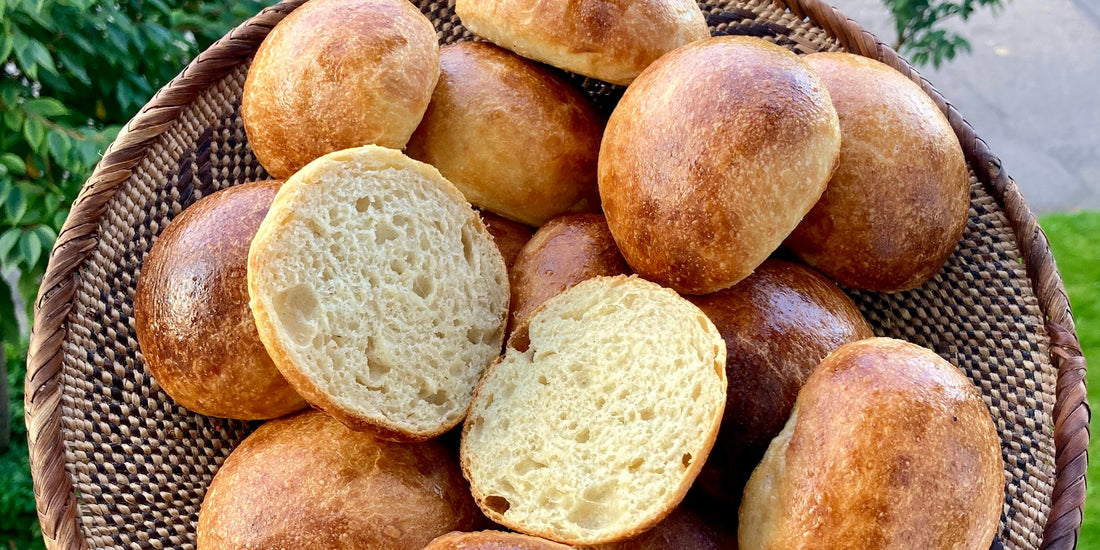
Brioche buns with kamut
Share
|
Ingredients :
Whole wheat flour from kamut, wheat flour, sourdough, eggs, water, sugar, , salt, butter. Tool: Bowl, dough spatula. |
Time consumption: Day 1 morning. Sourdough is refreshed. 2 minutes Day 2 dinner. Dough is mixed and folded. 3 hours Day 2 evening. Buns are shaped and baked. 2 hours. |
Gives approx. 14 small buns or 6-8 larger burger buns

I'm not a health freak, and I happily put plenty of butter, oil, eggs and/or sugar in the dough when it makes sense. So when there is wholemeal flour - and even a lot of it - in my soft brioche buns, it is not for health reasons but simply because it makes sense in terms of taste. And personally, I prefer to sink my teeth into something with structure rather than the brioche burger buns, which you can mash together completely into nothing and eat without being full, but in return be rewarded with a serious round of balloon stomach after consumption. With Kamut - also called giant durum - dear friends, there is full value for money.
The fact that it is Kamut that is chosen is because the flour from the large, light grains has a very fine, sweet taste, and when paired with butter and eggs, it ensures a wonderfully soft crumb. It absorbs quite a lot of liquid, but on the other hand it is so strong that the buns keep their shape, even if the dough feels very soft and sticky. It takes a bit of dexterity to shape them, so it might not be the very first recipe you have to throw yourself into as a newbie in the baking kitchen. But with a little practice, you get a result that is both excellent as birthday buns (then you can add a little cardamom if you're into that sort of thing) and as burger buns. And if you give them an oblong shape, you have the perfect sausage bread - my kids say so themselves, and I believe them! If you have the courage to scratch the dough a little more, you can instead fold it around small brunch sausages - et voilà: the most delicious sausage horns to curb the afternoon insanity in front of a few episodes of Gurli Gris and Ninjago.
Bon appetit!
Ingredients:
- 150 g whole grain kamut
- 350 g strong white wheat flour, e.g. Type xx
- 100-150 g refreshed sourdough*
- 1 egg (equivalent to approx. 50 g total, so if the egg is very small/large, the amount of water must be adjusted)
- Approx. 350 g lukewarm water - 50 g of this is retained
- 1 tablespoon of sugar
- 9 g of salt
- 50 g soft butter
- Beaten egg for brushing
Course of action:
Day 1, morning:
- Refresh your sourdough (see note below)
Day 1, morning/afternoon
- Mix the water (except the last 50 g), eggs and sugar and beat well; then dissolve the sourdough in the water. Add the flour and stir well until all the flour is wet.
- Let the dough rest for half an hour.
- Add salt, the last water and the soft butter. It's a bit of a snarky and fussy affair, and you can believe that it will never turn into a cohesive dough. But it will probably be! Squeeze and knead the dough until the butter is well distributed. Let it rest for 10 minutes before kneading well. If you have a mixer, you can use it with advantage, but otherwise it works perfectly with a little knuckle grease.
- After kneading, the dough must have three series of stretches and folds with approx. 20-30 minute interval - see Michael's video below.
- After the last series, the dough should be completely silky smooth. It's a little sticky to work with because of how wet and buttery it is, but don't add more flour, part will just make it heavy and the finished buns dry and boring.
- The dough must rise in a warm place for two to three hours, until it has grown approx. 50%**
Day 1, afternoon
- Carefully turn the dough out of the bowl/bucket and divide it into the number of buns you want. As I said, it is a bit sticky, and if you are gifted with a fairly sharp eye, I would recommend that you do not bother weighing the pieces, but simply chop off a suitable piece with your dough scraper and shape it by turning it around, as Michael shows in his preshape video below. That is each small piece of dough is treated like a small loaf. And touch it as little as possible: I usually push the dough under itself with the help of the dough scraper, which I move in semi-circles, while I just support the dough a little with the help of a few fingertips dipped in water. When the ball of dough is perfectly stretched and completely round, I quickly lift it onto the baking sheet.
- Repeat until all the buns are formed and brush them with egg wash.
- Let the buns rise on the kitchen counter for 1-2 hours, depending on how warm it is in the kitchen. If you are in a bit of a hurry, you can put the plate in the oven and turn on the light. Then they get a little warm and are protected from drafts. Just remember to take them out for the last half hour while the oven heats up to 200 degrees.
- Brush the buns again, place them in the middle of the oven and throw a small cup of water into the bottom to create steam. Let them bake for approx. 10-20 minutes depending on the size (and the nature of the oven!), or until they have just the golden color you like best. It should sound hollow when you lightly tap the bottom of a bun. However, be careful not to bake them for too long, because then the crumb will become dry.
*See possibly my note about very fresh, light sourdough for sweet breads in the recipe for challah . But then, if the time isn't for it, just use the sourdough you already have - then the buns might get a little more sour, but I think it works really well, especially for burgers and sausages. I've even baked these on fresh sourdough a couple of times and it turned out really well.
**You can also leave the dough to rise in the fridge until the next morning, if you want, for example, fresh buns for breakfast. In that case, you can advantageously push the whole process so that you only mix the dough in the afternoon or evening: the longer it is in the fridge, the more acid will appear in the taste at the end.
The dough is folded and stretched (Extracts from Rugkop's online baking course )
Video: Dough is shaped into a ball (Excerpt from Rugkop's online baking course )
Anyone can learn to bake light sourdough bread. Buy our online course and have flour and equipment delivered to the door.
